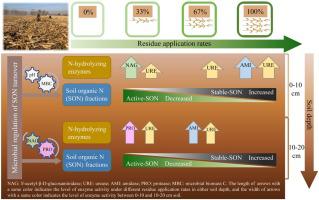Soil and Tillage Research ( IF 6.5 ) Pub Date : 2021-05-06 , DOI: 10.1016/j.still.2021.105044 Guohui Wu , Zhenhua Chen , Nan Jiang , Hui Jiang , Lijun Chen

|
Soil nitrogen (N) cycling can be affected by no-tillage and crop residue application. However, it remains unclear how crop residue application rates affect soil organic N (SON) fractions, N-hydrolyzing enzymes and their relationships. A field experiment was conducted in northeastern China to investigate the effects of no-tillage (NT) and residue application at either 0 (NTR0%), 33 (NTR33%), 67 (NTR67%) or 100% (NTR100%) on SON fractions, soil N-hydrolyzing enzyme activities, and their relationships at depths of 0−10 and 10−20 cm. The results showed that in the 0−10 cm soil layer, compared with the NTR0% treatment, concentrations of hydrolysable NH4+-N, amino sugar-N and active-SON and N-acetyl-β-d-glucosaminidase (NAG) activity were significantly increased in the NTR33% treatment. Amidase showed a significantly higher activity under the NTR100% treatment. Urease activity was significantly increased in residue application treatments. In the 10−20 cm soil layer, compared to the NTR0% treatment, the NTR33% treatment showed a significantly higher concentration of active-SON. Concentrations of hydrolysable unknown-N and stable-SON were significantly increased in both NTR67% and NTR100% treatments. NTR33% and NTR67% treatments significantly increased protease and amidase activities, respectively, and urease showed a significantly higher activity under the two treatments. The results of redundancy analysis indicated a relationship of SON fractions with soil microbial biomass carbon and pH in the 0−10 cm soil layer, and with protease and NAG activities in the 10−20 cm soil layer. These results suggested that crop residue application at a low rate (33 %) had a greater potential for enhancing active SON supplies, whereas moderate and high rates (67 % and 100 %) of crop residue application were more effective in maintaining a stable SON pool in the Phaeozem area of northeastern China.



























 京公网安备 11010802027423号
京公网安备 11010802027423号